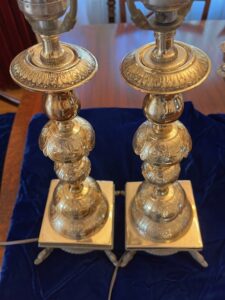 Leichter, or candlesticks used for Shabbos, serve as a precious reminder of someone’s great-grandparents from the Old Country. Often they brought the set, or single candlestick, as one of their few possessions from Eastern Europe to the USA. People often ask me about Shabbat Leichter. RD owns a pair with grapevine designs on a baluster shape.
Leichter, or candlesticks used for Shabbos, serve as a precious reminder of someone’s great-grandparents from the Old Country. Often they brought the set, or single candlestick, as one of their few possessions from Eastern Europe to the USA. People often ask me about Shabbat Leichter. RD owns a pair with grapevine designs on a baluster shape.
At one point somebody drilled the silver plate to house an electric cord, then filled it back in. He doesn’t believe they are sterling. I concur. They’re Polish silverplate, which makes a highly interesting story. If he investigates I bet he will find the mark “Fraget W Warszawie” and he will see the Polish double headed eagle.
Sail back with me to 1815
After the ravages of Europe, victory in the war with Napoleon made Russia an enticing place to live. A flow of European immigrants came to Russia including craftsmen, jewelers, scientists, and scholars. Many fell in love with the newly annexed Polish Kingdom of Russia, with the capital Warsaw. To entice business, Russia gave special dispensation to entrepreneurs such as no taxes for sales within the Empire. One such team, the brothers Fraget from France, founded a silversmithing shop in 1824. This factory became the most famous in the Russian Empire for silver pieces like RD’s Leichter. In fact by the end of the 19th century the word FRAGET replaced the word SILVER in common parlance.
Jozef Fraget heard about the new process the Elkington cousins recently patented in 1840 in London. The galvanization of a thin coat of silver on a copper or brass base metal became known as “silverplating.” Jozef skilled himself in the Old School method of silverplating, whereby his craftsmen soldered a thin sheet of silver to a red hot copperplate via rolling. He realized that galvanized silverplate meant less expensive production costs and less silver used in the process. In 1847 he took his new bride to Paris to study the technique “borrowed” from London by the silver company Christofle. They obtained permission to develop galvanized silverplate in 1844. Jozef immediately recognized the potential.
When he returned to Warsaw in 1849 he overhauled his factory. He renaming it Company Jozef Fraget, and created a smelting department for the silver base Alpaca. Jozef formed a laboratory for the study of electrolysis, whereby a thin coat of silver is fused on a base of brass or copper under high voltage, Neusilber. He sought out an Austrian mass production machine for the creation of 1800 pieces of base metal flatware a day for dining, which he then galvanized with silver.
His Son Julian Inherited the Booming Business
Julian brought it to new heights with appearances at World’s Fairs. The firm obtained the use of the Russian State Coat of Arms, the double headed eagle. He died in 1906, leaving the business to his daughter. She ran the company until the Nazi occupation of Poland in 1939. She reopened and nationalized the company in 1945.
RD’s candlesticks remind us of two important eras that may have impacted one of RD’s relatives. First the migration of talented Europeans to Warsaw took place in the early 19th century. Second, the wave of immigrants coming to America from the Russian Empire in the late 19th and early 20th century.
The wealthiest families in 1895 maybe purchased Russian 84 Standard silver Leichter. Sterling silver is .925 parts (out of 1000) silver over other metals and Russian 84 Standard is .875 parts silver over other metals. The exception is that 84 in a hallmark also refers to the total grams used in a SET of flatware silver-plated. It’s a way of bragging just how much PURE silver went into the galvanization process. In other words, Standard 84 can refer to the silver used in a dozen spoons and a dozen forks in pre-revolutionary Russia. Knives weren’t silver plated and purchased separately.
I owe some of the insights in this article to Dr DN Nikogosyan of the Association of Small Collectors of Antique Silver. He published an article on the changing hallmarks or “Touches” used by the Fraget Company over its many years as one of the two premier plate factories in the Empire. Fraget and Norblin, both located in Warsaw, were the center of the silver and silver-plate world.